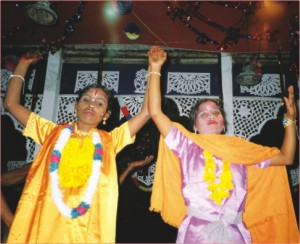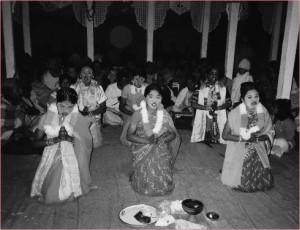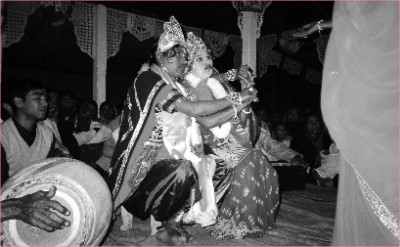| Cover Story
From Gazipur
Krishna Lila

For centuries, villages of Bangladesh have been staging plays based on Hinduism which, over the years, have evolved from being only about Hindu deities and have included others such as Sri Chaitanya Deb of Boishnobism. This issue's cover story is about “Krishno Lila”, one such play that is organized every year in Gazipur.
Saymon Zakaria
 IN Bangladesh, there are stage and open-yard productions based on Hinduism which, over the years, have evolved from being only about Hindu deities and have included preachers of similar yet other faiths, such as Sri Chaitanya Deb of Boishnobism. These plays center around Chaitanya, but the play is directed within an overall framework of “Krishna Lila” or “Ram Lila”. Usually these plays present how Sri Chaitanya left the material world (became a Shannashi). Alongside, the same plays include popular excerpts of “Krishno Lila”. IN Bangladesh, there are stage and open-yard productions based on Hinduism which, over the years, have evolved from being only about Hindu deities and have included preachers of similar yet other faiths, such as Sri Chaitanya Deb of Boishnobism. These plays center around Chaitanya, but the play is directed within an overall framework of “Krishna Lila” or “Ram Lila”. Usually these plays present how Sri Chaitanya left the material world (became a Shannashi). Alongside, the same plays include popular excerpts of “Krishno Lila”.
Originally, these plays were wholly dependent on the stories surrounding “Krishno”, but the inclusion of Chaitanya as the central character has gained popularity and are commonly known as “Nimay Shonnash”. Stories involving Krishno in the form of songs and plays are found throughout the villages of Bangladesh, and they have been reiterated in various local dialects. When Chaitannya Deb was alive, in the sixteenth century (between 1486 and 1533), plays and stage productions centering Krishno was popular. The Boishnob religion preached by Sri Chaitanya Deb at the time had a significant impact on the then Bengali community. In recorded biographies of Chaitanya Deb, it has been cited that he once played an important character in “Krishno Lila”.
In Chuariakhola village of Kaliganj thana in Gazipur, one such “Krishno Lila” is staged every first Thursday of the English year. A gathering of people and regular musical nights are arranged for at least two weeks prior to “Nimay Shonnash” of “Krishno Lila”, at Sri Sri Kanailal temple. Ordinary villagers are the main audience of the show, which is organized around a Kodom-Tomal tree in the evening. The audience sits in a circular fashion surrounding the tree, and the stage is the jute-mat covered open yard with the audience at the periphery and the tree at the centre. Musicians sit nearest to the tree to a side, and before the show is about to begin, the audience seems to build up to a large number, and the last row is seen standing at the back to get a decent view.
One particularly interesting trait about this show is the age of performers, usually school-going girls aged between 12 and 15 who read in classes between 6 and 9. Although, the male performers are usually in their middle ages. The show begins with six girls who sit near the musicians and sing songs of “Gourango-Nityanando”. At the end of their performance, they stand up, circle the staging area and leave. After this, the palakar (prompter/ director) enters the stage and sits at one side to oversee the production, and the play begins. One important fact to note here is that the palakar not only directs the show from his memory, but also the musicians.
 “Krishno Lila” is a mixture of various plays that have been enacted in Bangladesh for centuries. Moreover, it bring together music, songs, dialogue and dance. The next paragraph is an excerpt of the play itself which is presented from Nimay's mother's point of view and is set at the time when Nimay makes up his mind to leave the material world to meditate for enlightenment. “Krishno Lila” is a mixture of various plays that have been enacted in Bangladesh for centuries. Moreover, it bring together music, songs, dialogue and dance. The next paragraph is an excerpt of the play itself which is presented from Nimay's mother's point of view and is set at the time when Nimay makes up his mind to leave the material world to meditate for enlightenment.
Mother: It's so far into the day already and Nimay and Nitay still has not returned home. I have searched for them almost everywhere! Oh, there they are now.
(As she approaches them, she sees tears in her sons' eyes.
Mother: I wonder what the two brothers are saying
I wonder why they cry
Please tell me, my sons
Why do you cry?
Nitay: If you don't understand what I am feeling from looking at my face, then why are you my mother? I fear if I tell you, you will cry too…
 Mother: Please tell me why I might cry too, please tell me why you cry. Mother: Please tell me why I might cry too, please tell me why you cry.
Nitay: It pains me to speak the words
My mouth does not want to say
Nimay will leave our society
Nimay will leave this world to go and meditate (Shonnash)
Mother: What are you saying, Nitay?
Are you really leaving, Nimay?
Please stay at home with me and call me mother
Don't leave this woman in plight.
Nimay: Don't believe what brother is saying, mother. Do you think it is that easy? Do you think I'll be lucky enough to be able to achieve what I have set my sights on? So, don't believe what Nitay is saying. Let's return home together.
The dialogue above is a mixture of dialogue and song, with music thrown in at the right bits to arouse emotion and make the scene complete. Originally, only men used to act in such plays, and even the female characters were portrayed by male actors in disguise. It was only in 1990 when women were introduced in female characters by the famous palakar (director) Nogendro De. Such plays have been organized in Gazipur for the last one hundred years. Now, female characters receive the major share of the stage, with male actors in supporting roles mostly.
Palakars who are well known for staging plays in Gazipur and surrounding areas are: Bivuronjon Biswas (45) and Purnochandra De (65). Amongst the most popular performers are Sujata Biswas (15), Konika De (14), Rita Das (13), Momota Rani Das (13), Shuchorita Das (14), Shulekha Das (13), Joykumar De (65), Ripon De (27), Ramjoy Das (55) and Rohinikanto Das (56).

Translated by Zahidul Naim Zakaria
Copyright
(R) thedailystar.net 2009
|


 IN Bangladesh, there are stage and open-yard productions based on Hinduism which, over the years, have evolved from being only about Hindu deities and have included preachers of similar yet other faiths, such as Sri Chaitanya Deb of Boishnobism. These plays center around Chaitanya, but the play is directed within an overall framework of “Krishna Lila” or “Ram Lila”. Usually these plays present how Sri Chaitanya left the material world (became a Shannashi). Alongside, the same plays include popular excerpts of “Krishno Lila”.
IN Bangladesh, there are stage and open-yard productions based on Hinduism which, over the years, have evolved from being only about Hindu deities and have included preachers of similar yet other faiths, such as Sri Chaitanya Deb of Boishnobism. These plays center around Chaitanya, but the play is directed within an overall framework of “Krishna Lila” or “Ram Lila”. Usually these plays present how Sri Chaitanya left the material world (became a Shannashi). Alongside, the same plays include popular excerpts of “Krishno Lila”. “Krishno Lila” is a mixture of various plays that have been enacted in Bangladesh for centuries. Moreover, it bring together music, songs, dialogue and dance. The next paragraph is an excerpt of the play itself which is presented from Nimay's mother's point of view and is set at the time when Nimay makes up his mind to leave the material world to meditate for enlightenment.
“Krishno Lila” is a mixture of various plays that have been enacted in Bangladesh for centuries. Moreover, it bring together music, songs, dialogue and dance. The next paragraph is an excerpt of the play itself which is presented from Nimay's mother's point of view and is set at the time when Nimay makes up his mind to leave the material world to meditate for enlightenment. Mother: Please tell me why I might cry too, please tell me why you cry.
Mother: Please tell me why I might cry too, please tell me why you cry.